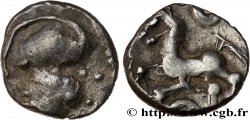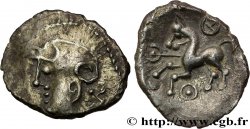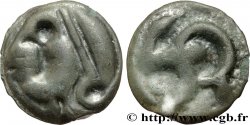bga_398524 - GALLIA - ÆDUI (BIBRACTE, Area of the Mont-Beuvray) Statère en électrum au triskèle, type de Chenôves
无库存.
所有在网站上销售的产品 (2018)
价格 : 685.00 €
所有在网站上销售的产品 (2018)
价格 : 685.00 €
种类 Statère en électrum au triskèle, type de Chenôves
日期: c. 70-50 AC.
铸币厂名称/城市 Autun (71)
材质 electrum
直径 19,5 mm
模子方针 9 h.
重量 6,33 g.
稀少度 R2
关于品相的说明
Statère sur un flan large et irrégulier, en très bas électrum, presque en billon. Frappe molle et usure marquée mais les types de droit et de revers sont bien identifiables
家谱
Cet exemplaire provient de la collection R. et D. Chevallier
正面
正面的文字 ANÉPIGRAPHE.
正面的说明书 Tête humaine laurée à gauche, la chevelure stylisée et une accolade devant la bouche ; grènetis.
背面
背面的文字 ANÉPIGRAPHE.
背面的说明书 Cheval galopant à gauche ; au-dessus du cheval, l'aurige ; triskèle sous le cheval.
评论
Ces monnaies du type de Chenôves se divisent en trois types ; à la lyre (classe I), à la rouelle (classe II) ou au triskèle (classe III). Ce statère avec la tête à gauche correspond à la classe III.
Le traitement de la chevelure correspond exactement à celle du statère DT. 3176 avec les mèches en forme de goutte et aux extrémités enroulées.
Le traitement de la chevelure correspond exactement à celle du statère DT. 3176 avec les mèches en forme de goutte et aux extrémités enroulées.








 对产品描述纠错
对产品描述纠错 打印
打印 分享我的选择
分享我的选择 提问
提问 Consign / sell
Consign / sell
 产品介绍
产品介绍



